AI Summary
Wondering why certain emails, upon landing in your inbox, instantly catch your attention? Well, it’s all about choosing the right ‘From Name’ and ‘From Email’.
Where a convincing ‘From Name’ focuses on building recognition, the ‘From Email’ assists in creating trust for users receiving your emails.
In this guide, we’ll provide detailed information regarding these two elements, along with tips to select the right ‘From Name’ and ‘From Email.’
In This Article
Understanding the ‘From Name’
The ‘From Name’ in an email is the name that appears in the inbox of your recipients, indicating who the email is from. As a result, it is perhaps one of the most crucial aspects of successful email communication, which directly influences whether or not someone opens your email.
It’s amazing how something so fundamental can impact your email open rates and click-through rates, right? So, it’s only wise you choose the right ‘From Name.’ This is especially important in an age where people are bombarded with emails and are cautious about spam or phishing attempts.
Best Practices for Selecting a ‘From Name’
When you’re contemplating how to choose a ‘From Name,’ it’s important to understand what resonates best with your audience. You may choose to use your company name, or if you need to create a more personal touch, you may use a specific person’s name.
1. Full name
If you want to create a personal connection with those receiving your emails, it’s a great decision to use a person’s full name as the ‘From Name.’ Not only does this help with personal branding, but it also showcases a sense of professionalism. This is especially important for emails from freelancers, consultants, and other professionals.

When an email recipient notices a full name approaching them, it immediately shows them that a ‘human’ is sending it, which creates a sense of trust. Basically, it signals to the recipient that the email is not coming from a bot, but rather from an identifiable person who has a presence in the online world.
Bear in mind though that it’s important to use a full name that your readers can recognize. If you’re not well-known amongst the recipients you’re sending your email to, chances are that they won’t be able to associate you with your brand. In such circumstances, it’s better to pair your name with a business name.
2. First name at company
Like we were talking about before, if you’re not that well-known amongst recipients, it’s better to use the “First name at company” format in your emails as the ‘From Name’. This way, you can create a personal element with your name that also connects to your brand or business name.

For instance, “Jane Doe from XYZ Corporation” is a format that’s useful for businesses where personal interaction is key, such as customer service, sales, or client relations. A lot of businesses choose this style for their ‘Form Name’ as it makes the email sound more professional and approachable.
However, as emphasized earlier, it’s vital that you choose a name that your recipients are familiar with or intend to familiarize them with. It’s a good practice to usually use the name of a person who has a public-facing role and/or is the primary point of contact for your email clients, as it helps maintain a personal connection.
3. Company name
Using the “Company Name” as the ‘From Name’ in your emails is a direct and clear approach, especially suitable for official or formal business communications. This format is widely used by companies when they want to ensure instant brand recognition and maintain a professional tone in their correspondence.

Usually, it’s a great idea to utilize the “Company Name” as the sender name if the purpose of your emails is “transactional” in nature. For instance, this style is suited for brands that want to send order confirmations, shipping notifications, or service updates to keep customers in the know.
At the same time, this approach can also prove to be quite handy for your email marketing or newsletter campaigns, where the primary focus is to establish a brand presence among readers. Since your company name provides immediate context, recepients won’t even have to open your email to understand the nature of it.
4. Genre / Service Type
Another best practice around ‘From Name’ revolves around using a combination of the “Company name with the Genre / Service Type.” This is mainly suited for those businesses that are providing products/services across various industries or have multiple brands that focus on different offerings.

For instance, let’s talk about “Google” which operates in different domains. You can see in the screenshot above it uses ‘Email Names’ like “Google Alerts” for alert-related communications, “Google Ads” for advertisement updates, or “Google Calendar” for its calendar service.
Similarly, “Slickdeals Money” focuses on finance-related emails. This method is highly effective in segmenting the email content according to different services or genres, providing clarity to the recipients. It lets customers immediately recognize the email’s relevance to their interests or needs.
The Importance of ‘From Email’
The ‘Form Email’ is typically the email address that’s being used to send the emails from your SMTP provider. It’s just as important as the ‘From Name’, as your ‘From Email’ showcases that the email is being sent from an authentic business or person.
As a result, selecting the right ‘From Email’ is incredibly important, as it assures the recipients that your email is legitimate and safe to open.
Tips for Choosing an Effective ‘From Email’
When it comes to selecting the right ‘From Email’, there are several factors that come into play. You’ll need to use a custom domain that reflects your business’s website and avoid using generic email addresses, among other tips:
1. Avoid free webmail addresses
If you choose to use a free webmail address, such as those from Hotmail, Gmail.com, or Yahoo, it doesn’t give much of a legitimate feeling and may even be considered spam, which is something you want to avoid at all costs. Therefore, avoid using a free webmail address to ensure that your emails are taken seriously by recipients.
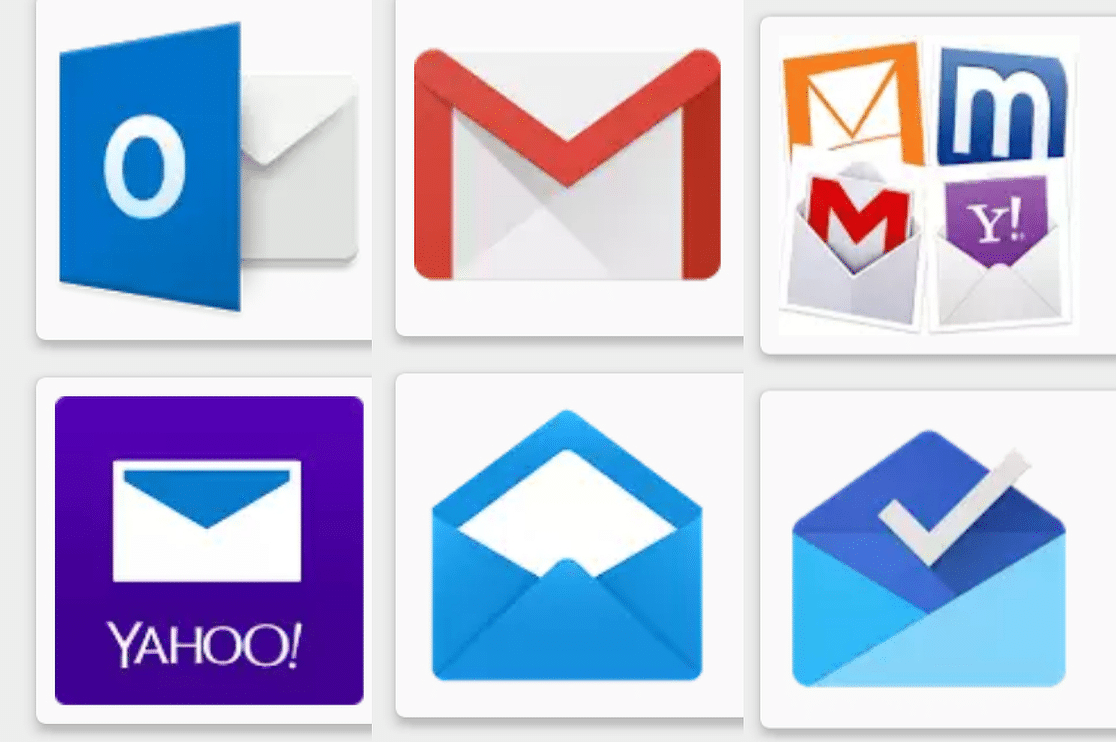
Domain-specific email addresses have a higher rate of success and even ensure better deliverability. It adds a layer of authenticity and showcases that the person sending emails belongs to a professional organization.
2. Select a valid business email address
There’s a reason why whenever an employee joins a new company, they’re assigned a business email with a domain-specific email address for all internal and external communications. A work email address makes your communication look more professional.
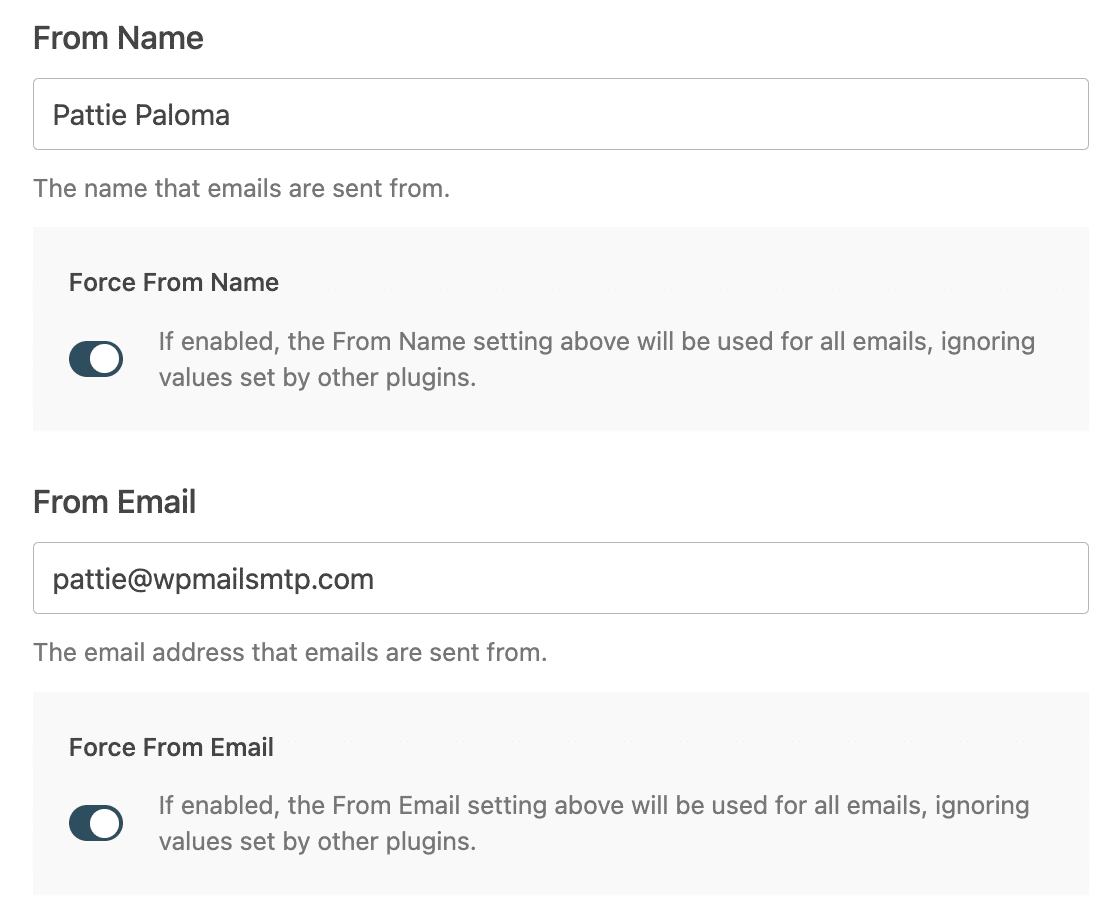
In addition, business email addresses are also less likely to be flagged as spam in comparison to free webmail addresses. You see, many email servers are configured to automatically reject free email services, as they are commonly used for spam and phishing attempts.
Therefore, if you want to enjoy a higher success rate and better email deliverability to your recipients, always use a business email address that contains the company’s own domain name, such as ‘@yourcompanyname.’ It signals to the recipient that the email comes from a legitimate and established business entity.
3. Avoid using a no-reply address
One of the biggest mistakes most people make when selecting a ‘From Email’ for their business and marketing communication is to use a no-reply email address. While this may seem like a small issue, it can create barriers when it comes to forming a meaningful connection with your audience.
There are many email service providers that automatically flag no-reply addresses as being less important or unsolicited mail. Not to mention, most of the time, emails sent from a no-reply address end up making their way to the spam folder. In contrast, using a reply-able email address provides a better experience for your recipients.
This is, of course, based on the assumption that you’re using a no-reply email for the purposes of business and marketing-related email campaigns, which is not recommended. However, there are other use cases where no-reply email addresses prove to be handy, particularly for;
- Password resets
- Account creations
- Account deactivations
- Application submissions
- Order/purchase confirmations
- Subscription confirmations
- Unsubscribe confirmations
- Event RSVP confirmations
- Government messages
- and more!
4. Specific email addresses for different functions
A smart strategy to use when deciding your ‘From Email’ is to understand the different functions of your business communication. For instance, if you send a monthly newsletter, you should use an email address like ‘newsletters@.’
Similarly, if you want to create a system for support tickets where you can send and reply to customer questions and troubleshooting emails, you can use ‘support@.’ And for billing-related information, you can use ‘billing@.’
Having a distinct email address for each type of communication helps in categorizing emails and managing them efficiently. It makes it easier for recipients to recognize and prioritize emails based on their immediate needs or interests.
Integrate ‘From Name’ and ‘From Email’ with WP Mail SMTP
Just a heads up: WordPress uses PHP by default for sending emails from your website, and unfortunately, it doesn’t always provide the best email deliverability.
So, if you have WP Mail SMTP installed but you’re still using the default PHP Mailer, it means that the plugin is not in control of your emails.
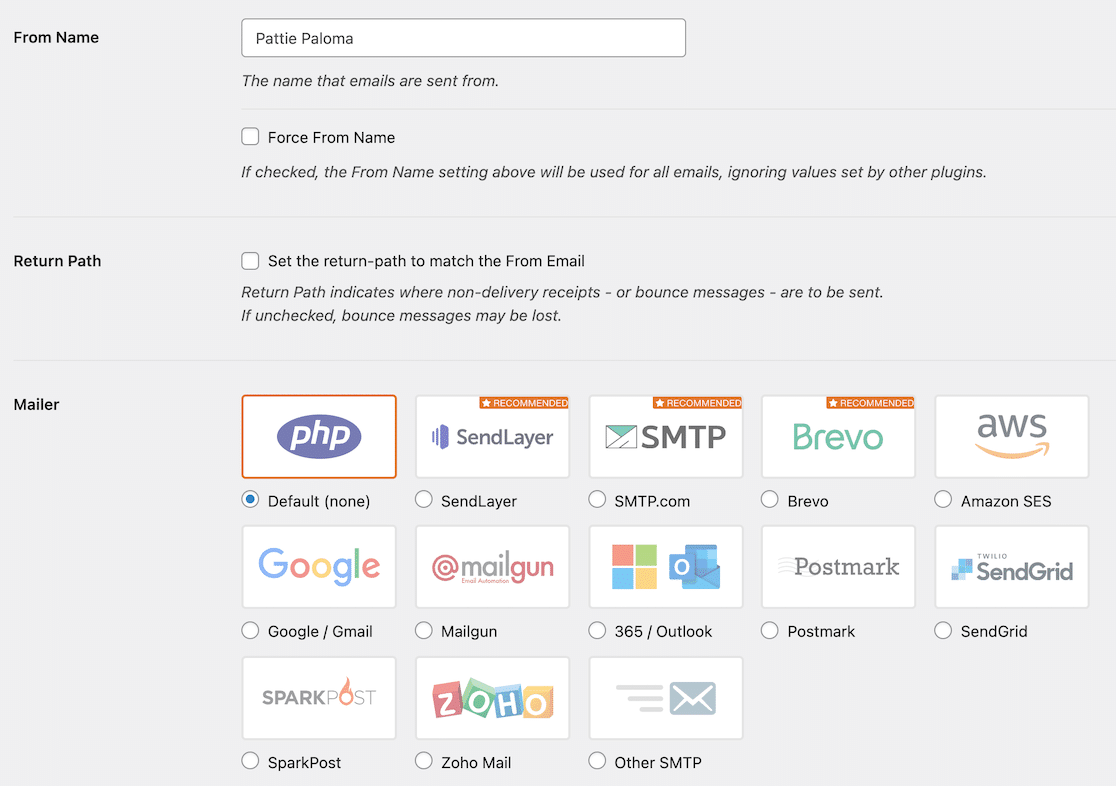
Configure ‘From Name’ and ‘From Email’ in WP Mail SMTP
It’s necessary to use a mailer different from PHP for emails to be sent out successfully. So, if you haven’t already configured WP Mail SMTP, review the documentation for your preferred mailer in the table below:
| Mailers available in all versions | Mailers in WP Mail SMTP Pro |
|---|---|
| SendLayer | Amazon SES |
| SMTP.com | Microsoft 365 / Outlook.com |
| Brevo | Zoho Mail |
| Google Workspace / Gmail | |
| Mailgun | |
| Postmark | |
| SendGrid | |
| SparkPost | |
| Other SMTP |
Though many choices are available, we suggest using SendLayer, SMTP.com, or Brevo (previously Sendinblue). When it comes to sending transactional emails, these mailers are some of the most reliable choices out there.
Need a hand?
You can purchase White Glove Setup as an additional service with any of our WP Mail SMTP licenses and have our customer support team set up WP Mail SMTP for you.
If you are looking for something that’s simpler to set up, then we highly recommend getting the WP Mail SMTP Pro License, which offers a One-Click-Setup Feature for the Google / Gmail mailer.
The setup guides in the table above should guide you on the ‘From Name’ and ‘From Email’ to use, but in case you want to change it, go to WP Mail SMTP » Settings and click on the General tab.
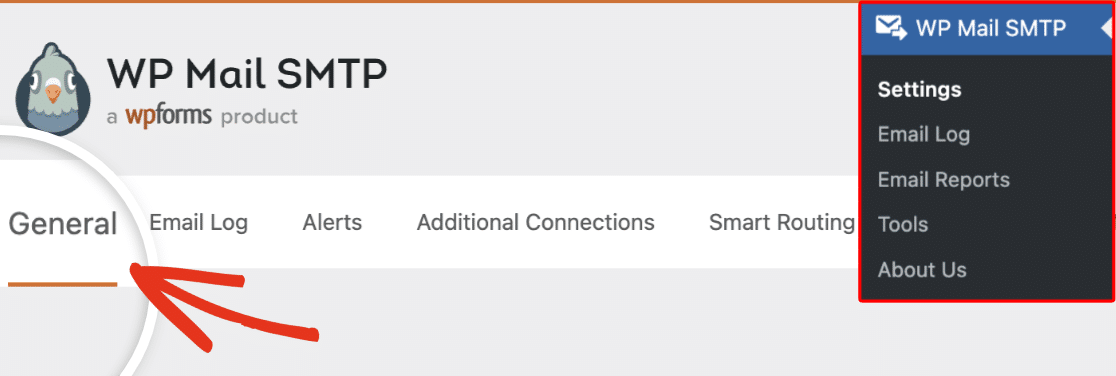
At the top of this page, you can set the From Email and From Name. You can add any From Name you want, and you can also Force From Name to make this setting work across the whole site.
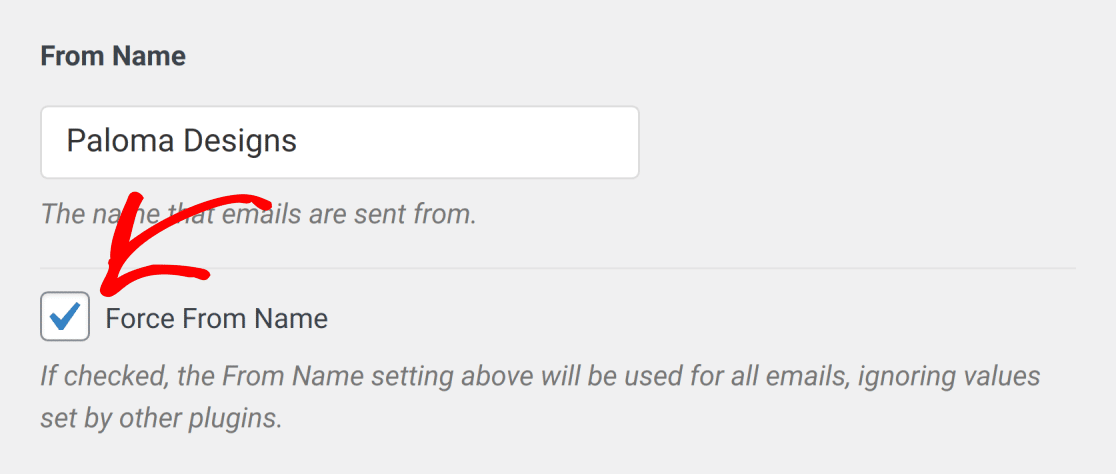
Similarly, for the From Email, you can use any valid email address. You can also check the box that says Force From Email, if you want the same email account across the whole site, without editing the email settings in different locations.
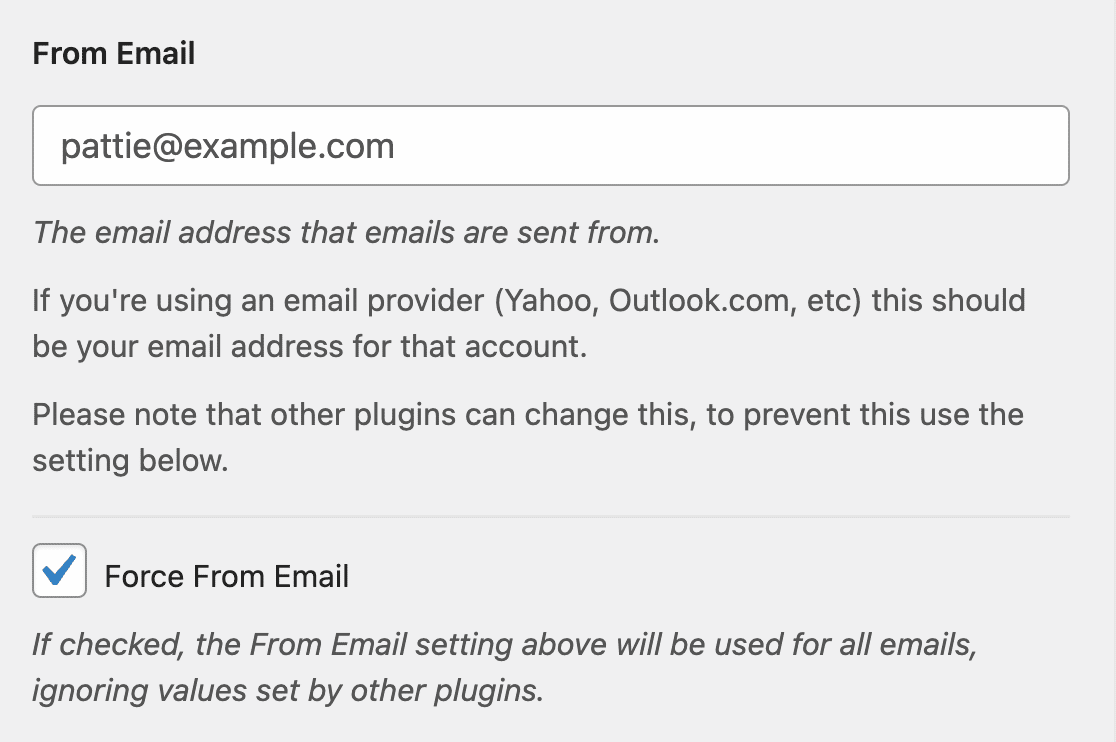
Also, you should check the Return Path box if you want to set the return path to match the From Email. If you turn this on, you’ll get an email if any texts fail to reach their destination because of problems with their email.

And that’s all there is to it! Thanks to WP Mail SMTP, you’ve now changed the email sender information for your WordPress emails. Just make sure to hit Save before navigating away from the settings page.
And if you’re interested in more customization tips, like how to change the sender information and other details of your email templates, check out our helpful tutorial.
More Questions about From Name and From Email
Learning to configure your sender email details is a popular topic among our readers. Here are answers to some questions we get asked about it:
What is the format for email address and name?
The format for an email address typically follows the structure: [username]@[domain].[domain extension], such [email protected]. The ‘From Name’ in emails is the sender’s name displayed to the recipient, usually formatted as a full name, first name, or business name.
It’s the first identifier of who the email is from, seen before the email is even opened. WP Mail SMTP is a tool that allows users to easily configure both the ‘From Email’ address and ‘From Name’ to ensure they are correctly formatted and professional, enhancing the effectiveness of your email communication.
What is the best practice for from name in email?
The best practice for a ‘From Name’ in emails is to use a name that recipients will immediately recognize and associate with your brand name. This could be a personal name, a company name, or a combination of both.
Consistency in the display name is key to building recognition and trust. For businesses, using a tool like WP Mail SMTP can be particularly effective as it allows for easy configuration and consistency in the ‘From Name’, ensuring it aligns with your brand identity and communication goals.
How important is email from name?
The ‘From Name’ in an email is extremely important as it significantly influences the recipient’s decision to open the email. It’s the first point of recognition and can impact the perceived credibility and relevance of the email.
A well-chosen ‘From Name’ builds trust, enhances brand recognition, and can increase open rates. Tools like WP Mail SMTP allow businesses to effectively manage their ‘From Name’, ensuring it resonates with the audience and reflects the brand’s identity, which is crucial for successful email communication and engagement.
Next, Learn How to Fix Could Not Connect to SMTP Host in WordPress
The ‘could not connect to SMTP host’ error is a commonly encountered error in WordPress, which results in your emails failing to send. Check out this guide for the most common problems that result in the ‘could not connect to SMTP host’ error and how to fix them.
Ready to fix your emails? Get started today with the best WordPress SMTP plugin. If you don’t have the time to fix your emails, you can get full White Glove Setup assistance as an extra purchase, and there’s a 14-day money-back guarantee for all paid plans.
If this article helped you out, please follow us on Facebook and Twitter for more WordPress tips and tutorials.

